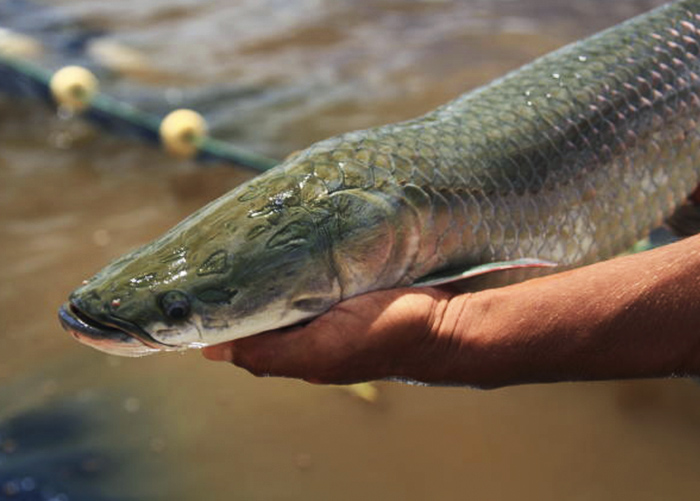Researcher identifies over 400 substances secreted by pirarucu heads
Researcher identifies over 400 substances secreted by pirarucu heads
An important step towards the domestication of pirarucu (Arapaima gigas), the largest of Brazil's native fish, was given by the researcher from Embrapa Fisheries and Aquaculture, Lucas Simon Torati: the discovery of hormones, proteins, peptides and likely pheromones in the liquid secreted by the head of adult animals. The scientist analyzes the hypothesis that the fry directly benefit from such secretion due to its biochemical composition. The research identified more than 400 proteins secreted by the fish. The discovery was published in the scientific journal Plos One.
In his PhD thesis defended at the University of Stirling, in Scotland, Torati was able to demonstrate that such secretion contains sexual steroids possibly used as pheromones, hormones that cause attraction for mating. The scientist observed that whenever the level of such hormones was high in blood samples, it was also high in the head's secretion. Such unprecedented revelation proved the unique nature of pirarucu. Generally speaking, fish release pheromones through semen or urine, but in no other species their presence was identified in head liquid.
The research also verified that the mucus has proteins that can benefit the fry, which would be one of the causes that would justify the constant presence of younglings over the top of the head of the fish. “In this region there are cavities that, once they are pressed, they release a type of milk through the pores. Several hypotheses had been raised, such as that the fry feed from this liquid, a sort of lactation. Young discus fish eat mucus from their parents' head, but there is not much data to validate this hypothesis in the case of pirarucu”, Torati reports. “As a matter of fact, there is not even scientific terminology to refer to the secretion that the fish releases through the head”, he comments.
A large portion of the research was conducted in collaboration with the National Department of Works Against Droughts (DNOCS of the Ministry of National Integration, which has an aquacultural research center in the city of Pentecoste, 85 kilometers away from Fortaleza, the capital city of Ceará state. The partnership allowed the scientist to monitor the sexual steroids of 20 couples.
Researcher Lucas Toratti talks about the substances secreted by pirarucu and their likely functions
Proteins for the immunological system
The research also advanced in the study of the relationship between the secretion and parental care, addressed by the paper in Plos One. It was the first time the presence of protein and peptides was identified in such mucus, which, according to Lucas Torati, despite its reduced amount, could benefit the fry, since there are several proteins in adult pirarucus' immunological system. That would cause the offspring to remain close to the male's head. “The composition of the secretion could benefit the fry's immunological system. Another reason for them to be always around the male's head is for protection. Their main predator is birds, and when pirarucus are providing parental care, the head of the father becomes darker, and camouflages their spawn”, Torati describes.
The studies have also identified the presence of prolactin in the secretion, which in other species is related to parents' care with their younglings. In tilapias (Oreochromis niloticus), for instance, the increase in this hormone is related to the rise in the mucus from which the fry feed. “In the case of pirarucu, we do not know if this occurs with the head's secretion, but now at least we can raise this hypothesis from our discovery”, the researcher observes.
The characterization of the genetic diversity in natural populations was also the target of research. For that purpose, last-generation sequencing tools were used. Torati explains that, depending on the place where the pirarucus live, their genetic diversity changes. “We have observed that populations from the Amazon and Solimões Rivers have a much higher genetic diversity than those from the Araguaia River. And the region of Tucuruí, which is located between those two basins, shows an intermediary genetic diversity”, he reports.
The study consisted in DNA sequencing. The markers generated from the genome were used to understand the genetic variation of populations in the Tucuruí, Araguaia, Amazon, Solimões rivers and in a captive population. Thus it was possible to characterize the stocks, and the molecular markers generated, of the SNP type, can be used in the future to identify broodfish and characterize their genetic diversity.
Mysterious giant
Pirarucu is an Amazonian fish that is full of mysteries. The theme of indigenous legends and the livelihood of riverside populations in the North of the country, the endagered species still generates many doubts about its morphology, physiology and reproduction.
Originally from the Amazon, Tocantins-Araguaia and Essequibo (French Guyana) basins, the pirarucu (Arapaima gigas) is the largest scaled freshwater fish of the planet, with fast weight gain, reaching 250 kilos and three meters.
According to indigenous stories, the male and the female release a kind of milk from their heads in their parental care period. The Embrapa researcher identified only one translucent watery secretion. “I had always heard stories that it was milky and white, however, in the samples that I collected, it was shown to be watery and mucous. It like a more viscous water”, the researcher details.>
“Once we were in a field day in Manaus and I then asked some Indigenous fishermen, who would watch pirarucus pass by their canoes for whole days, about what they thought of such secretion. They assured me that it was a milk that you see come out in the water”.
Translation: Mariana Medeiros
Elisângela Santos (MTb:19.500/RJ)
Embrapa Fisheries and Aquaculture
Press inquiries
pesca-e-aquicultura.imprensa@embrapa.br
Phone number: +55 63 32129-7834
Further information on the topic
Citizen Attention Service (SAC)
www.embrapa.br/contact-us/sac/



